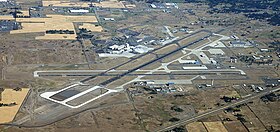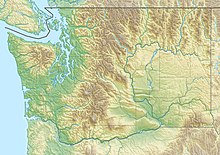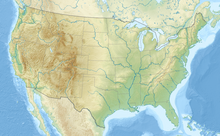Spokane International Airport
Spokane International Airport Geiger Army Airfield | |||||||||||||||
|---|---|---|---|---|---|---|---|---|---|---|---|---|---|---|---|
 | |||||||||||||||
 Spokane International Airport in 2010, viewed from the south | |||||||||||||||
| Summary | |||||||||||||||
| Airport type | Public | ||||||||||||||
| Owner | Spokane County & City of Spokane | ||||||||||||||
| Operator | Spokane Airport Board | ||||||||||||||
| Serves | Inland Northwest | ||||||||||||||
| Location | Spokane, Washington, USA | ||||||||||||||
| Hub for | |||||||||||||||
| Elevation AMSL | 2,385 ft / 727 m | ||||||||||||||
| Coordinates | 47°37′12″N 117°32′02″W / 47.62000°N 117.53389°W | ||||||||||||||
| Website | SpokaneAirports.net | ||||||||||||||
| Map | |||||||||||||||
| Runways | |||||||||||||||
| |||||||||||||||
| Statistics (2016) | |||||||||||||||
| |||||||||||||||
Source: Spokane International Airport[1] | |||||||||||||||
Spokane International Airport (IATA: GEG, ICAO: KGEG, FAA LID: GEG) is a commercial airport located approximately 5 miles (8 km) west of downtown Spokane, Washington. It is the primary airport serving the Inland Northwest, which consists of 30 counties and includes areas such as Spokane and The Tri-Cities, both in Eastern Washington, and Coeur d'Alene in North Idaho. The airport's code, GEG, is derived from its airfield's namesake, Major Harold Geiger.
As of 2015, Spokane International Airport (GEG) ranks as the 70th-busiest airport in the United States in terms of passenger enplanements.[2] At 3,234,095 total passengers served in 2016, it is also the second busiest airport in Washington and is classified as a small hub. GEG is currently served by five airlines with non-stop service to 13 airports in 12 markets.
History
Origins


Known as Sunset Field before 1941, it was purchased from the county by the War Department and renamed Geiger Field after Major Harold Geiger, an Army aviation pioneer who died in a crash in 1927.
During World War II, Geiger Field was a major training base by Second Air Force as a group training airfield for B-17 Flying Fortress heavy bombardment units, with new aircraft being obtained from Boeing near Seattle. It was also used by Air Technical Service Command as an aircraft maintenance and supply depot; Deer Park Airport and Felts Field were auxiliaries.
Geiger Field was served by a rail connection to the Great Northern Railway.[3]
Geiger was closed in late 1945 and turned over to War Assets Administration (WAA), then transferred to Spokane County and developed into a commercial airport. The airport hosted USAF Air Defense Command interceptor units during the Cold War for air defense of Hanford Nuclear Reservation and Grand Coulee Dam. Built in 1942 as the Spokane Air Depot, Fairchild Air Force Base is four miles (7 km) to the west.
It became Spokane's municipal airport in 1946, replacing Felts Field, and received its present name in 1960, after the City of Spokane was allotted Spokane Geiger Field by the Surplus Property Act.[4] The airport code is still GEG, for Geiger Field.
Modern era

The current Concourse A and B complex opened in 1965 and was designed by Warren C. Heylman and William Trogdon.[5]
Occasional non-stop flights to southern California since the 1970s have been among the first to be suspended during economic downturns.
Growth and expansion
A second level was added to Concourse A and Concourse B in 1974.[6]
The airport has a Master Plan,[7] which includes a third runway and gates added to Concourse C.
A new control tower has been built south of the airport, replacing the one near Concourse C. The new control tower is the tallest one in the State. The Terminal, Rotunda, and Concourse C Enhancement Project (TRACE) was recently completed, designed by Bernardo/Wills Architects, P.C.[8] The project, which concluded in November 2006, added retail space and expanded security checkpoints in the airport's three concourses, and gave the Rotunda an aesthetic renovation. In 2010, 2000 feet was added to Runway 3–21, and parallel taxiways 'A' and 'G' enabling heavier aircraft departures in summer months.
The airport plans to add another concourse in the next 5–10 years and looks to add more direct flights to the east coast; the Spokane market has been hosting big events and attracting business to the area. [citation needed]
Facilities
Airfield
The airport operates two paved runways:
- Runway 3/21: 11,002 ft × 150 ft (3,353 m × 46 m), Asphalt/Concrete
- Runway 7/25: 8,199 ft × 150 ft (2,499 m × 46 m), Asphalt
Terminals
The passenger terminal facility at Spokane International Airport consists of three main structures; Concourse A and B in the center, Concourse C to the southwest, and the Ground Transportation Center to the north. The three structures are immediately adjacent and connected to one another, however the two concourses are not currently linked with an airside connector on the sterile side; as such, connecting passengers need to transit between the concourses through the landside, non-sterile circulation.
Concourse A and B


Concourse A and B are located in the same area and are connected by a central rotunda area with dining and shopping vendors. Concourse A houses 5 gates (11-15), while Concourse B houses 8 gates (1–8).
The concourse originally opened in 1965 and was designed by Warren C. Heylman and William Trogdon. Designed to the Neo-Expressionism style, the building's architecture prominently features exposed concrete as well as distinct sculpted and monolithic architectural shapes and forms. However, as the airport has continued to incrementally expand through its modern history, some of the original architectural intent of the Concourse A and B complex has been lost. While several expansions to the concourse matched and extended the original architectural style of the building, others additions have altered the original architecture. In 1974, a second floor was added to both Concourses A and B to allow for the implementation of passenger boarding bridge access to aircraft. The new floors, while sharing some material commonality with the original Heylman and Trogdon concourse, lacked the curvy and sculpted neo-expressionistic forms found in the former. The later additions of the ground transportation facility and Concourse C to the ends of the concourse building further altered the original architecture by replacing its distinct bookend elevations and entrances with corridors to the adjacent buildings. Interior renovations in the mid-2000s also removed a large amount of the original sculpted forms and monolithic materials of the Concourse A and B complex, replaced in favor of more rectilinear forms and contemporary finish materials. Despite this, a number of original architectural elements remain and are largely integral to the space today (such as the exposed concrete roof trusses and concrete columns), creating a juxtaposition between the newer elements and the original architecture.
Southwest Airlines is the current primary occupant operating in and out of Concourse A. Delta and United Airlines both operate in and out of Concourse B. American Airlines operated in and out of Concourse B before relocating to Concourse C in March 2016.
Concourse C

Concourse C houses 9 gates, both upper (30-32) and lower (21a, 21b, 22-26). The lower level gates house regional turboprop jets, while the upper level gates house narrow-body aircraft. The current iteration of Concourse C opened in 2000 after a $20 million redevelopment and expansion project. The project, which broke ground in 1998 added 80,000 square feet to the concourse including a new baggage claim and two-story passenger facility. The existing 11,000 square foot concourse was remodeled into service and operations functions.[9] The new Concourse C was designed with a more contemporary architectural style, contrasting the appearance of the Concourse A and B complex, by employing a large use of metal cladding and large curtain window walls on its exterior building envelope. However, it does draw some inspiration from its neo-expressionist neighbor by architecturally expressing a modular, repetitive, and exposed structural grid through its façade and interior lobby areas.
Alaska Airlines and its sister carrier Horizon Air were the primary occupants operating in and out of Concourse C after Frontier Airlines ceased operations to Spokane in January 2015.[10] However, that changed once American Airlines relocated to Concourse C in March 2016. Alaska and American operate in and out of the upper level gates, while Horizon operates in and out of the lower level gates.
Airlines and destinations
Spokane International Airport is served by 5 carriers. These carriers serve 12 markets through non-stop service to 13 airports.
Passenger




| Airlines | Destinations | Concourse |
|---|---|---|
| Alaska Airlines | Seattle/Tacoma Seasonal: Anchorage | C |
| Alaska Airlines operated by Horizon Air | Boise, Portland (OR), Seattle/Tacoma | C |
| American Airlines | Dallas/Fort Worth (begins July 8, 2017),[11] Phoenix–Sky Harbor | C |
| Delta Air Lines | Minneapolis/St. Paul, Salt Lake City Seasonal: Seattle/Tacoma | B |
| Delta Connection | Los Angeles, Salt Lake City, Seattle/Tacoma Seasonal: Minneapolis/St. Paul | B |
| Southwest Airlines | Boise, Denver, Las Vegas, Oakland, Phoenix–Sky Harbor Seasonal: Chicago–Midway, San Diego (begins June 4, 2017)[12] | A |
| United Airlines | Chicago–O'Hare (begins June 8, 2017),[13] Denver | B |
| United Express | Denver, San Francisco (resumes June 8, 2017)[14][13] | B |
Cargo
| Airlines | Destinations |
|---|---|
| Airpac Airlines | Seattle–Boeing |
| Ameriflight | Ephrata, Lewiston, Portland (OR), Seattle–Boeing, Tri-Cities (WA), Wenatchee, Yakima |
| FedEx Express | Indianapolis, Memphis, Oakland |
| FedEx Feeder operated by Empire Airlines | La Grande, Lewiston, Moses Lake, Pendleton, Portland (OR), Tri-Cities (WA), Wenatchee, Yakima |
| UPS Airlines | Dallas/Fort Worth, Des Moines, Louisville, Portland (OR), Seattle–Boeing, Vancouver |
| Western Air Express | Boise, Portland (OR) |
Statistics
Top destinations
| Rank | City | Passengers | Carriers |
|---|---|---|---|
| 1 | Seattle/Tacoma, Washington | 552,000 | Alaska, Delta |
| 2 | Denver, Colorado | 188,000 | Southwest, United |
| 3 | Portland, Oregon | 164,000 | Alaska |
| 4 | Salt Lake City, Utah | 128,000 | Delta |
| 5 | Minneapolis/St. Paul, Minnesota | 121,000 | Delta |
| 6 | Phoenix–Sky Harbor, Arizona | 103,000 | American, Southwest |
| 7 | Oakland, California | 85,000 | Southwest |
| 8 | Las Vegas, Nevada | 84,000 | Southwest |
| 9 | Boise, Idaho | 79,000 | Alaska, Southwest |
| 10 | Los Angeles, California | 25,000 | Delta |
| Rank | Airline | Passengers | Share |
|---|---|---|---|
| 1 | Horizon Air | 908,000 | 29.09% |
| 2 | Southwest Airlines | 745,000 | 23.88% |
| 3 | Delta Air Lines | 422,000 | 13.51% |
| 4 | Alaska Airlines | 406,000 | 13.01% |
| 5 | SkyWest Airlines | 244,000 | 7.83% |
Annual traffic
| Year | Passengers | Year | Passengers | Year | Passengers | ||
|---|---|---|---|---|---|---|---|
| 1990 | 1,619,880 | 2000 | 3,068,890 | 2010 | 3,181,616 | ||
| 1991 | 1,589,123 | 2001 | 2,880,186 | 2011 | 3,072,572 | ||
| 1992 | 1,855,954 | 2002 | 2,745,788 | 2012 | 3,005,664 | ||
| 1993 | 2,329,953 | 2003 | 2,789,499 | 2013 | 2,926,858 | ||
| 1994 | 2,687,482 | 2004 | 3,059,667 | 2014 | 2,986,652 | ||
| 1995 | 2,988,575 | 2005 | 3,197,440 | 2015 | 3,133,342 | ||
| 1996 | 3,258,762 | 2006 | 3,224,423 | 2016 | 3,234,095 | ||
| 1997 | 3,043,238 | 2007 | 3,471,901 | ||||
| 1998 | 2,949,833 | 2008 | 3,422,110 | ||||
| 1999 | 3,041,626 | 2009 | 3,055,081 |
Ground transportation
Spokane Transit operates two stops at Spokane International Airport, with bus route 60 connecting the airport to Downtown Spokane. Transfer opportunities are available in downtown to the rest of the STA system. The airport is also served by the WSDOT's Travel Washington Gold Line, which provides twice-daily bus service to cities north of Spokane, including Deer Park, Chewelah, Colville, and Kettle Falls.
A consolidated rental car facility is located adjacent to the Ground Transportation Center on the north end of the main terminal. The consolidated facility opened in November 2008, replacing several satellite operations, and is intended to meet passenger growth at the airport for 20 years after its opening.[19]
Accidents and incidents
- On January 21, 1981 a Beechcraft Model 99A, Cascade Airways flight 201, crashed into a hill 4.5 miles from the runway. The accident was caused by an incorrect distance measuring equipment frequency, and premature descent to minimum descent altitude. Of the nine people on board, seven were killed (including both pilots), and the other two passengers were seriously injured. The airline ceased operations about five years later.[20][21]
- On March 18, 1994, Douglas DC-3C N3433Y of Salair crashed shortly after take-off on a cargo flight to Portland International Airport. The starboard engine failed shortly after take-off. The engine that failed had previously been in long-term storage and had been overhauled the previous year and fitted to the aircraft on February 21, replacing an engine that developed a misfire and loss of power. It had accumulated 15 hrs flight time at the time of the accident. The aircraft was destroyed in the subsequent fire and both crew were killed.[22][23]
See also
- Washington World War II Army Airfields
- Western Air Defense Force (Air Defense Command)
- 9th Air Division
References
![]() This article incorporates public domain material from the Air Force Historical Research Agency
This article incorporates public domain material from the Air Force Historical Research Agency
- ^ "Spokane Intl Airport > Home" (PDF).
- ^ "Calendar Year 2015 Passenger Boardings at Commercial Service Airports" (PDF). Federal Aviation Administration (FAA). Retrieved February 27, 2017.
- ^ Staff, "Align Rail Route To Air Depot", The Spokesman-Review, Spokane, Washington, Wednesday 13 May 1942, Volume 59. Number 364, page 6.
- ^ "Spokane Intl Airport > Home".
- ^ "Historic Preservation: Mid-Century Modern Architecture".
- ^ "Terminal Roof Bid Accepted". The Spokesman-Review. Spokane. August 25, 1977. p. 7. Retrieved January 22, 2015.
- ^ "Spokane Intl Airport > Home".
- ^ "Spokane Intl Airport > Home".
- ^ "Airport projects set to take off". Spokane Journal of Business. Retrieved January 15, 2016.
- ^ "Frontier Airlines ending service at Spokane International Airport". Spokesman Review. Retrieved March 30, 2016.
- ^ "American Airlines announces new summer routes from DFW, five other hubs | American Airlines". Dallas News. Retrieved March 26, 2017.
- ^ "Southwest Airlines adds new service from June 2017". Routesonline. Retrieved March 26, 2017.
- ^ a b "United domestic routes addition from June 2017". Routes Online. Retrieved February 26, 2017.
- ^ "Timetable". Retrieved January 7, 2017.
- ^ "RITA - BTS - Transtats". Bureau of Transportation Statistics. Retrieved Feb 2017.
{{cite web}}: Check date values in:|accessdate=(help) - ^ "Spokane, WA: Spokane International(GEG)". Bureau of Transportation Statistics. Retrieved Feb 2017.
{{cite web}}: Check date values in:|accessdate=(help) - ^ "Spokane Intl Airport - Business > Doing Business > Passenger Data".
- ^ Historic Passenger & Cargo Data. Retrieved on Mar 28, 2015.
- ^ Prager, Mike (November 12, 2008). "Car rental a short walk away". The Spokesman-Review. Retrieved January 14, 2016.
- ^ [1][dead link]
- ^ [2][dead link]
- ^ "N3433Y Accident description". Aviation Safety Network. Retrieved June 25, 2010.
- ^ "SEA94FA085". National Transportation Safety Board. Retrieved June 28, 2010.
External links
- Spokane International Airport, official site
- Spokane International Airport at WSDOT Aviation
- FAA Airport Diagram (PDF), effective July 11, 2024
- FAA Terminal Procedures for GEG, effective July 11, 2024
- Resources for this airport:
- AirNav airport information for KGEG
- ASN accident history for GEG
- FlightAware airport information and live flight tracker
- NOAA/NWS weather observations: current, past three days
- SkyVector aeronautical chart for KGEG
- FAA current GEG delay information
- Airports established in 1940
- Airfields of the United States Army Air Corps
- USAAF Second Air Force Heavy Bombardment Training Stations
- Airfields of the United States Army Air Forces in Washington (state)
- Airports in Washington (state)
- Buildings and structures in Spokane County, Washington
- Transportation in Spokane County, Washington
- Transportation in Spokane, Washington
- 1940 establishments in Washington (state)




